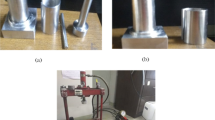Abstract
The current work deals with the methods employed for the measurement of several wick parameters, outlines the experimental setup developed to measure pore radius and presents the results. Bi-porous copper wicks with distinguished sizes and pore characteristics are successfully developed for loop heat pipes. The powder compaction is performed at 12 KN force, followed by sintering at three different temperatures and durations. Among these, the best sintering condition is identified as 923 k and 90 min. The characterisation of wick shows that the porosity of 49% and a maximum capillary pore radius of 85 nm have been achieved. SEM examination of the wick surface shows the existence of large pores, which leads to increased porosity and interconnects the fine pore network responsible for generating the required capillary pumping pressure. The permeability of the fabricated bi-porous samples is found to be in the range of 2.46 × 10−14 m2. The measured hardness of the sintered sample is found to be 37.4 HRB.
Access this chapter
Tax calculation will be finalised at checkout
Purchases are for personal use only
Similar content being viewed by others
References
Ahmed S, Pandey M, Kawaji M (2022) Loop heat pipe design: an evaluation of recent research on the selection of evaporator, wick, and working fluid. J Therm Sci Eng Appl 14(7):070801
Ahmed S, Nashine C, Pandey M (2022) Thermal management at microscale level: detailed study on the development of a micro loop heat pipe. Micro Nano Eng:100150
Nashine C, Pandey M (2022) Theoretical modelling of miniature loop heat pipe. In: ASTFE digital library. Begel House Inc., 2022
Nashine C, Pandey M (2021) Thermo-hydraulic modelling of miniature loop heat pipes. In: Proceedings of the 26thnational and 4th international ISHMT-ASTFE heat and mass transfer conference, December 17–20, 2021, IIT Madras, Chennai, 600036, Tamil Nadu, India. Begel House Inc., 2021
Xu J, Zou Y, Yang D, Fan M (2013) Development of biporous Ti3AlC2 ceramic wicks for loop heat pipe. Mater Lett 91:121–124
Samanta SK, Das P, Lohar AK (2013) Study of physical characteristics of nickel wicks developed by metal injection moulding. Powder Metall 56(3):221–230
Singh R, Akbarzadeh A, Mochizuki M (2009) Effect of wick characteristics on the thermal performance of the miniature loop heat pipe. J Heat Transf 131(8)
Singh R, Akbarzadeh A, Mochizuki M (2009) Experimental determination of wick properties for loop heat pipe applications. J Porous Media 12(8)
Prasad A, Anand AR, Raghavendra Kumar D, Ramakrishnan V, Ambirajan A, Kumar D, Dutta P (2014) Measurement of thermal conductivity, pore size, permeability and coefficient of thermal expansion of porous nickel wick for lhps. Heat Pipe Sci Technol An Int J 5(1–4)
Wu S-C, Tzu-Wei G, Wang D, Chen Y-M (2015) Study of PTFE wick structure applied to loop heat pipe. Appl Therm Eng 81:51–57
Deng D, Liang D, Tang Y, Peng J, Han X, Pan M (2013) Evaluation of capillary performance of sintered porous wicks for loop heat pipe. Exp Thermal Fluid Sci 50:1–9
Siedel B (2014) Analysis of heat transfer and flow patterns in a loop heat pipe: modelling by analytical and numerical approaches and experimental observations. PhD diss., INSA de Lyon
Choi J, Yuan Y, Sano W, Borca-Tasciuc D-A (2014) Low temperature sintering of copper biporous wicks with improved maximum capillary pressure. Mater Lett 132:349–352
Choi J, Sano W, Zhang W, Yuan Y, Lee Y, Borca-Tasciuc D-A (2013) Experimental investigation on sintered porous wicks for miniature loop heat pipe applications. Exp Thermal Fluid Sci 51:271–278
Anvesh C, Srikanth T, Jasvanth VS (2021) Characterization of sintered porous wick for use in loop heat pipe. In: Proceedings of the 26th national and 4th international ISHMT-ASTFE heat and mass transfer conference, December 17–20, 2021, IIT Madras, Chennai-600036, Tamil Nadu, India. Begel House Inc., 2021
Dullien FAL (1991) Porous media: fluid transport and pore structure. Academic Press, New York
Acknowledgements
The characterisation experiments were conducted at the Central Instruments Facility of IIT Guwahati.
Author information
Authors and Affiliations
Corresponding author
Editor information
Editors and Affiliations
Rights and permissions
Copyright information
© 2023 The Author(s), under exclusive license to Springer Nature Singapore Pte Ltd.
About this paper
Cite this paper
Nashine, C., Mohaddin, N.A., Kumar, R., Sarma, S.K., Pandey, M. (2023). Development and Characterisation of Bi-porous Metallic Wick for Loop Heat Pipes. In: Joshi, S.N., Dixit, U.S., Mittal, R.K., Bag, S. (eds) Low Cost Manufacturing Technologies. NERC 2022. Springer, Singapore. https://doi.org/10.1007/978-981-19-8452-5_10
Download citation
DOI: https://doi.org/10.1007/978-981-19-8452-5_10
Published:
Publisher Name: Springer, Singapore
Print ISBN: 978-981-19-8451-8
Online ISBN: 978-981-19-8452-5
eBook Packages: EngineeringEngineering (R0)




